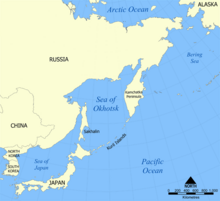Japanese evacuation of Karafuto and the Kuril Islands
This article needs additional citations for verification. (November 2010) |

The evacuation of
The evacuation started under the threat of Soviet invasion. As Japanese civilians evacuated Korea and Manchuria, they cleared out of the Karafuto and Kurile Islands according to the terms of the Potsdam Declaration that the terms of the Cairo Declaration would be carried out, and Japanese sovereignty would be limited to the Home Islands of Honshū, Hokkaidō, Kyushu, Shikoku and such minor islands as the Allies determined.
Timeline
Karafuto
This section needs additional citations for verification. (October 2015) |
The operation began with the crossing of the
), a powerful fortified district (FD). Severe fighting with heavy losses on both sides continued for over a week, with Soviet troops breaking the Japanese defenses on 18 August. The Soviets also landed their naval forces deep behind enemy frontlines to aid their ground forces.According to some of the 6,000 refugees already evacuated from the area, Soviet forces carried out fierce naval bombardment and artillery strikes against civilians awaiting evacuation as well as Japanese installations in
On 20 August, after Japan's surrender, fearing that they would be raped by the invading Soviet troops, nine of the twelve female operators poisoned themselves. Three were saved by male colleagues' intervention. The survivors at the post office were treated well by the Soviets.[2]
On 16 August, the coastguard ).
During the
The rest of the Japanese Maoka defenders retreated by Tei (now
On 25 August, another 1,600 men landed in Otomari (now Korsakov). The Japanese garrison of 3,400 men laid down their arms with almost no resistance and surrendered.
Some vessels of the last convoy, including civilian evacuees, had been sunk by Soviet submarines in the
Kuriles
The rout of Japanese forces in
By the end of August, all the northern Kuriles were under the control of Soviet forces, including
In the
Fate of Western residents and Allied prisoners in the area
Similar treatment faced the
Some versions (including the work of American researchers[
The final fate of the supposed
See also
- Battle of the Kuril Islands
- Evacuation of Manchukuo
- Evacuation of East Prussia
- Japanese repatriation from Huludao
- Soviet assault on Maoka
- Soviet Invasion of South Sakhalin
- World War II evacuation and expulsion
References
- ^ a b c d Ealey, Mark (26 February 2006). "An August Storm: the Soviet-Japan Endgame in the Pacific War". The Asia-Pacific Journal: Japan Focus. Retrieved 14 November 2010.
- ^ Murakawa, Miyuki Mourners mark WWII Sakhalin post office suicides, The Japan Times 12 January 2015, Retrieved 29 July 2015
- ^ "TASK FORCE RUSSIA -- BIWEEKLY REPORT 19 DECEMBER 1992-8 JANUARY 1993 12TH REPORT TASK FORCE RUSSIA (POW/MIA) REPORT TO THE U.S. DELEGATION, U.S.-RUSSIAN JOINT COMMISSION ON POW/MIAs 8 JANUARY 1993". memory.loc.gov. Retrieved 30 July 2022.
